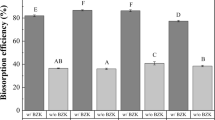Abstract
Chromium can be removed from ground water by the unicellular yeast, Saccharomyces cerevisiae. Local ground water maintains chromium as CrO4 2- because of bicarbonate buffering and pH and E h conditions (8.2 and +343 mV, respectively). In laboratory studies, we used commercially available, nonpathogenic S. cerevisiae to remove hexavalent chromium [Cr(VI)] from ground water. The influence of parameters such as temperature, pH, and glucose concentration on Cr(VI) removal by yeast were also examined. S. cerevisiae removed Cr(VI) under aerobic and anaerobic conditions, with a slightly greater rate occurring under anaerobic conditions. Our kinetic studies reveal a reaction rate (Vmax) of 0.227 mg h-1 (g dry wt biomass)-1 and a Michaelis constant (Km) of 145 mg/l in natural ground water using mature S. cerevisiae cultures. We found a rapid (within 2 minutes) initial removal of Cr(VI) with freshly hydrated cells [55–67 mg h-1 (g dry wt biomass)-1] followed by a much slower uptake [0.6–1.1 mg h-1 (g dry wt biomass)-1] that diminished with time. A materials-balance for a batch reactor over 24 hours resulted in an overall shift in redox potential from +321 to +90 mV, an increase in the bicarbonate concentration (150–3400 mg/l) and a decrease in the Cr(VI) concentration in the effluent (1.9-0 mg/l).
Similar content being viewed by others
References
Apel WA & Turick CE (1992) Remediation of hexavalent chromium contamination using microbially catalyzed chromate reduction. In: Stiger SG (Ed) Proceedings of the International Topical Meeting on Nuclear and Hazardous Waste Management Spectrum 1992, Vol 2 (1019–1023). American Nuclear Society, Inc., La Grange Park, Illinois
Borst-Pauwels GWFH (1981) Ion Transport in Yeast. Biochim. Biophys. Acta 650: 88–127
Brady D & Duncan JR (1994) Bioaccumulation of metal cations by Saccharomyces cerevisiae. Appl. and Environ. Biotechnology 41: 149–154
de Rome L & Gadd GM (1991) Use of pelleted and immobilized yeast and fungal biomass for heavy metal and radionuclide recovery. J. Indust. Microbiol. 7: 97–104
Fude L., Harris B, Urrutia MM & Beveridge T (1994) Reduction of Cr(VI) by a consortium of sulfate-reducing bacteria (SRB III). Appl. Environ. Microbiol. 60: 1525–1531.
Fuhrmann G F & Rothstein A (1968) The transport of Zn+2, Co+2 and Ni+2 into yeast cells. Biochim. Biophys. Acta. 163: 325–330
Gadd GM (1990a) Heavy metal accumulation by bacteria and other microorganisms. Experientia 46: 834–840
Gadd GM (1990b) Metal Tolerance, In: Edwards C (Ed) Microbiology of Extreme Environments (pp 178–210). Open University Press, Milton Keynes
Gadd G M & Griffiths AJ (1978) Microorganisms and heavy metal toxicity. Microb. Ecol. 4: 303–317
Huang C, Chin-Pao H, & Morehart AL (1990) The removal of CuII from dilute aqueous solutions by Saccharomyces cerevisiae. Water Res. 24: 433–439
International Agency for Research on Cancer (IARC) (1973) Monograph on the evaluation of carcinogenic risk of chemicals to man. 2: 120
Ishibashi Y, Cervantes C, & Silver S (1990) Chromium reduction in Pseudomonas putida. Appl. Environ. Microbiol. 56: 2268–2270
McNab WW & Narasimham TN (1994) Degradation of chlorinated hydrocarbons and groundwater geochemistry: a field study. Environ. Sci. Technol. 28: 769–775
Mehlhorn RJ, Buchannan BB, & Leighton T (1993) Bacterial chromate reduction and product characterization. In: Means JL & Hinchee RE (Eds) Emerging Technology for Bioremediation of Metals (26–37). Lewis Publishers, Boca Raton, Florida
Mehlhorn RJ, Fry I & Krauter P (1995) Analysis of hexavalent chromium by Saccharomyces cerevisiae. Lawrence Livermore National Laboratory UCRL-JC-119558
Norris PR, Kelly DP (1977) Accumulation of cadmium and cobalt by Saccharomyces cerevisiae. J. Gen. Microbiol. 99: 317–324
Shen H & Wang H (1994) Biological reduction of chromium by E. coli. J. Environ. Eng. 120: 560–572
Shi X, Dalal NS & Vallyathan V (1991) One-electron reduction of carcinogen chromate by microsomes, mitochondria, and Escherichia coli: identification of Cr(V) and ·OH Radical. Arch. of Biochem. and Biophys. 290: 381–386
Strandberg GW, ShumateII SE, & Parrott JR (1981) Microbial cells as biosorbents for heavy metals: accumulation of uranium by Saccharomyces cerevisiae and Pseudomonas aeruginosa. Appl. Environ. Microbiol. 41: 237–245
Venitt SL & Levy S (1974) Mutagenicity of chromates in bacteria and its relevance to chromate carcinogenesis. Nature 250: 493–495
Volesky B (1990) Biosorption by fungal biomass. In: B. Volesky (Ed) Biosorption of Heavy Metals. CRC Press, Inc. Boca Raton, Florida
Wang YT & Shen H (1995) Bacterial reduction of hexavalent chromium. J. Indust. Microbiol. 14: 159–163
Author information
Authors and Affiliations
Rights and permissions
About this article
Cite this article
Krauter, P., Martinelli, R., Williams, K. et al. Removal of Cr(VI) from ground water by Saccharomyces cerevisiae . Biodegradation 7, 277–286 (1996). https://doi.org/10.1007/BF00115741
Accepted:
Issue Date:
DOI: https://doi.org/10.1007/BF00115741




